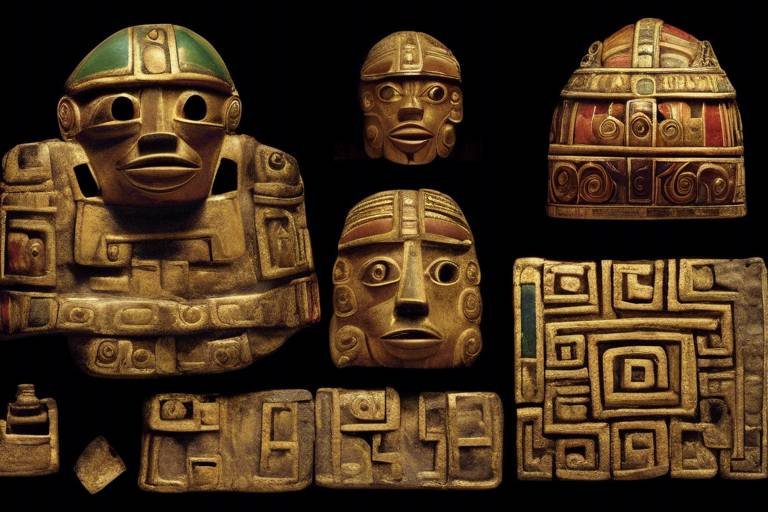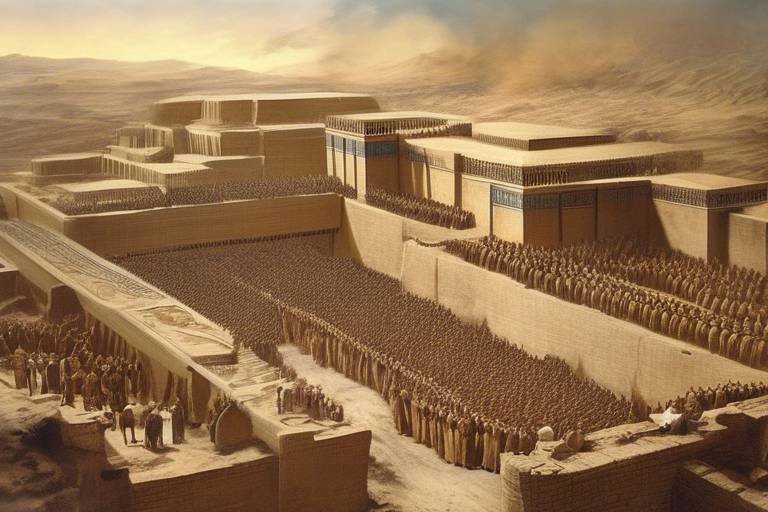The Forgotten Civilizations of Central Asia
Central Asia, a region shrouded in mystery and intrigue, holds within its vast landscapes the remnants of ancient civilizations that have long been forgotten by the annals of history. These lost societies, once vibrant and thriving, have left behind tantalizing clues to their existence, waiting to be unearthed and explored by curious minds.
Imagine a time when great empires rose and fell, leaving behind traces of their grandeur in the form of majestic ruins and intricate artifacts. Central Asia, often overshadowed by more well-known civilizations, harbors a treasure trove of cultural heritage waiting to be rediscovered and celebrated.
As we journey through the annals of time, we encounter the Silk Road empires that once dominated the trade routes, connecting distant lands and fostering the exchange of goods and ideas. The Indus Valley Civilization, with its advanced urban planning and sophisticated culture, stands as a testament to the ingenuity of ancient peoples who thrived in the harsh terrains of Central Asia.
Among the nomadic Scythians and the mercantile Sogdians, we find tales of bravery and enterprise that shaped the history of the region. The Greco-Bactrian Kingdom, a fusion of Greek and Persian influences, emerged as a beacon of cultural exchange and innovation in Central Asia.
The Timurid Empire, led by the formidable conqueror Timur, left an indelible mark on the political landscape of Central Asia, while the Parthian Empire wielded its power across vast territories, influencing the geopolitics of the ancient world.
The Kushan Empire, a melting pot of diverse cultures, facilitated the flow of ideas between East and West, leaving behind a legacy of artistic and intellectual achievements that continue to inspire to this day.
As we reflect on the forgotten civilizations of Central Asia, we are reminded of the enduring legacy they have left behind in the form of art, architecture, trade, and the exchange of knowledge. These ancient societies, though lost to time, continue to whisper their stories to those willing to listen, inviting us to delve deeper into the rich tapestry of Central Asian history.

The Silk Road Empires
The Silk Road Empires were a network of powerful civilizations that rose and fell along the ancient trade routes of the Silk Road, connecting the East and West in a web of commerce and cultural exchange. These empires, such as the Han Dynasty of China, the Parthian Empire of Iran, and the Roman Empire, controlled key points along the Silk Road, shaping the flow of goods, ideas, and technologies across Central Asia.
Imagine the bustling markets of Samarkand, where merchants from distant lands converged to trade silk, spices, and precious metals. The Silk Road Empires not only facilitated the exchange of exotic goods but also served as conduits for the transmission of knowledge, religions, and artistic influences between civilizations.
At the heart of the Silk Road lay the city of Dunhuang, a vibrant oasis on the edge of the Taklamakan Desert. Here, travelers rested and replenished their supplies before embarking on the arduous journey through the treacherous Silk Road passes. The Silk Road Empires flourished in this harsh yet fertile landscape, leaving behind a legacy of cultural syncretism and innovation.
The Silk Road Empires were not merely economic entities but also centers of intellectual and artistic exchange. Buddhist monks carried scriptures from India to China, while Greek artisans introduced new techniques to Central Asian craftsmen. The legacy of the Silk Road Empires can be seen in the diverse architectural styles, religious practices, and culinary traditions that have endured to this day.

Indus Valley Civilization
Central Asia is rich in history, yet many of its ancient civilizations remain unknown to the world. This article explores the fascinating cultures and societies that once thrived in this region, shedding light on their contributions to human history.
Discover the powerful empires that controlled the lucrative trade routes of the Silk Road, connecting East and West and facilitating the exchange of goods, ideas, and cultures across Central Asia.
The is a remarkable ancient urban culture that flourished in what is now modern-day Pakistan and parts of Central Asia. Known for its advanced urban planning, sophisticated drainage systems, and intricate craftsmanship, this civilization dates back to the 3rd millennium BCE. The cities of Mohenjo-Daro and Harappa are testament to the organized and technologically advanced society that thrived in the region. The Indus Valley Civilization engaged in trade with Mesopotamia, Egypt, and other regions, showcasing its economic prowess and cultural exchange.
Learn about the nomadic Scythian tribes and the mercantile Sogdian people, who played crucial roles in the history of Central Asia through their military prowess, trade networks, and cultural achievements.
Explore the legacy of Bactria, a region known for its rich cultural heritage and the establishment of the Greco-Bactrian Kingdom, which blended Greek and Persian influences in Central Asia.
Delve into the rise of the Timurid Empire, founded by the legendary conqueror Timur (Tamerlane), whose reign reshaped the political landscape of Central Asia and left a lasting impact on the region.
Examine the Parthian Empire, a powerful Iranian civilization that controlled vast territories in Central Asia and played a significant role in shaping the geopolitics of the ancient world.
Discover the cultural and artistic achievements of the Kushan Empire, a major power in Central Asia that facilitated the exchange of ideas between India, China, and the Mediterranean world.
Reflect on the enduring legacy of the forgotten civilizations of Central Asia and their contributions to art, architecture, trade, and the spread of knowledge throughout the ancient world.
Stay tuned for answers to common questions about the forgotten civilizations of Central Asia!

The Scythians and Sogdians
The Scythians and Sogdians were two distinct groups that left a profound impact on the history of Central Asia. The Scythians, known for their nomadic lifestyle, roamed the vast steppes of the region, displaying remarkable military prowess and fierce independence. They were skilled horsemen and archers, feared by many for their swift and deadly attacks. The Scythians established a powerful presence in Central Asia, influencing neighboring cultures and shaping the political landscape of the time.
On the other hand, the Sogdians were renowned for their mercantile activities and cultural achievements. As skilled traders, the Sogdians played a vital role in connecting the East and West through their extensive trade networks along the Silk Road. They were known for their expertise in commerce, facilitating the exchange of goods, ideas, and technologies between different civilizations. The Sogdians were also pioneers in art, literature, and architecture, leaving behind a rich cultural legacy that continues to captivate historians and archaeologists.
Despite their differences in lifestyle and pursuits, both the Scythians and Sogdians contributed significantly to the diversity and vibrancy of Central Asian civilizations. Their interactions with other cultures and their unique characteristics added layers of complexity to the region's history, creating a dynamic tapestry of traditions and innovations.

Bactria and the Greco-Bactrian Kingdom
Bactria, a region steeped in history and cultural significance, holds a pivotal place in the narrative of Central Asia. Known for its rich cultural heritage, Bactria became the cradle of the Greco-Bactrian Kingdom, a unique blend of Greek and Persian influences that left an indelible mark on the region.
The Greco-Bactrian Kingdom emerged as a result of the conquests of Alexander the Great, who brought Hellenistic culture to the heart of Central Asia. This fusion of Greek and Persian traditions gave rise to a flourishing civilization that thrived in the diverse landscape of Bactria.
One of the defining features of the Greco-Bactrian Kingdom was its vibrant art and architecture, characterized by a synthesis of Greek artistic techniques and local Central Asian styles. This artistic legacy reflected the cultural exchange and mutual influence that defined the kingdom's identity.
Moreover, the Greco-Bactrian rulers actively promoted cultural interchange, facilitating the exchange of ideas between the Mediterranean world, India, and Central Asia. This cultural cross-pollination not only enriched the artistic landscape of the region but also fostered intellectual growth and innovation.
The legacy of the Greco-Bactrian Kingdom extended beyond its borders, influencing subsequent civilizations in Central Asia and leaving a lasting imprint on the cultural tapestry of the region. The kingdom's legacy serves as a testament to the dynamic interplay of diverse cultures and the enduring impact of cross-cultural interactions in shaping the history of Central Asia.

The Timurid Empire
The Timurid Empire, a formidable realm established by the renowned conqueror Timur, commonly known as Tamerlane, holds a significant place in the annals of Central Asian history. Timur, a master tactician and military genius, rose to power in the 14th century and forged an empire that stretched from modern-day Turkey to India, encompassing vast territories in Central Asia. His conquests were marked by unparalleled brutality and strategic brilliance, earning him a fearsome reputation that echoed across the region.
Under Timur's rule, the Timurid Empire flourished as a center of art, culture, and learning, attracting scholars, artisans, and intellectuals from far and wide. The capital city of Samarkand, renowned for its stunning architecture and advanced urban planning, became a beacon of civilization in the heart of Central Asia. Timur's patronage of the arts and sciences led to a golden age of creativity, with intricate mosaics, majestic monuments, and vibrant literary works adorning the empire.
Despite his military prowess, Timur was also a shrewd statesman who implemented innovative administrative reforms to govern his vast domains effectively. His empire became a melting pot of diverse cultures and ethnicities, fostering a climate of tolerance and exchange that enriched the social fabric of Central Asia. Timur's legacy as a conqueror and statesman continues to influence the region to this day, shaping its political dynamics and cultural landscape.
The Timurid Empire's influence extended far beyond its borders, leaving a lasting imprint on the art, architecture, and traditions of neighboring civilizations. Timur's descendants, known as the Timurids, continued to rule parts of Central Asia and Persia, perpetuating his legacy of grandeur and refinement. The empire's decline in the 16th century marked the end of an era, but its impact on the cultural heritage of Central Asia endures, serving as a testament to the enduring legacy of Timur and his empire.

The Parthian Empire
The Parthian Empire, a formidable Iranian civilization that rose to power in Central Asia, commanded vast territories through its military might and strategic alliances. Known for their skilled cavalry and expertise in archery, the Parthians established themselves as a dominant force in the region, challenging the influence of neighboring empires.
One of the defining features of the Parthian Empire was its adeptness in managing diverse cultures and fostering trade along the Silk Road. The Parthians facilitated the exchange of goods, ideas, and technologies between the East and West, contributing to the flourishing commerce and cultural exchange in Central Asia.
With their capital at Ctesiphon, the Parthians developed a sophisticated administrative system and promoted urbanization, leading to the growth of thriving cities and centers of learning. Their rule saw the construction of impressive monuments, such as the majestic city of Seleucia on the Tigris, showcasing the empire's architectural prowess.
Notable for their diplomatic acumen, the Parthians engaged in complex political maneuvers to maintain their influence in the face of external pressures. Their interactions with the Roman Empire and other regional powers shaped the geopolitics of the ancient world, often resulting in strategic alliances and conflicts that reshaped the balance of power in Central Asia.
Furthermore, the Parthian Empire made significant contributions to art and culture, blending Iranian traditions with influences from Hellenistic and Eastern civilizations. Their artistic achievements, including intricate metalwork and vibrant textiles, reflected a synthesis of diverse cultural influences that characterized the vibrant cultural landscape of Central Asia during their reign.

The Kushan Empire
The Kushan Empire, a significant power in Central Asia, left a remarkable mark on the region's history with its cultural and artistic achievements. This empire served as a vital bridge for the exchange of ideas between the diverse civilizations of India, China, and the Mediterranean world. The Kushans were known for their patronage of art and architecture, which resulted in a flourishing artistic scene characterized by a unique blend of styles from different regions.
One of the most notable contributions of the Kushan Empire was the promotion of Gandharan art, a distinctive artistic style that combined elements of Greek, Roman, Persian, and Indian art. This fusion of cultural influences resulted in the creation of magnificent sculptures and reliefs that reflected the cosmopolitan nature of the Kushan society.
Moreover, the Kushans played a crucial role in facilitating trade along the Silk Road, connecting distant lands and enabling the exchange of goods, technologies, and ideologies. This economic prosperity not only enriched the empire but also fostered cultural interactions that influenced the development of art, religion, and philosophy in Central Asia and beyond.

The Legacy of Central Asian Civilizations
Central Asia, often overlooked in discussions of ancient civilizations, holds a treasure trove of history waiting to be uncovered. The legacy of Central Asian civilizations is a testament to the region's rich cultural tapestry and its enduring impact on the development of human society. From art to architecture, trade to knowledge exchange, these forgotten civilizations have left an indelible mark on the world.
One of the most remarkable aspects of Central Asian civilizations is their role as cultural crossroads, where ideas and innovations from East and West converged. This cultural exchange not only enriched the societies of Central Asia but also influenced the development of neighboring regions, creating a vibrant melting pot of diverse influences.
Artistically, Central Asian civilizations have left behind a legacy of exquisite craftsmanship and creativity. The intricate designs of pottery, the majestic sculptures, and the breathtaking architecture bear witness to the skill and artistry of these ancient cultures. Their artistic achievements continue to inspire and captivate audiences around the world.
Moreover, Central Asia's contribution to trade and commerce cannot be overstated. The ancient Silk Road, with its network of trade routes connecting distant lands, facilitated the exchange of goods, technologies, and ideas, laying the foundation for globalization long before the term was coined. Central Asian civilizations played a pivotal role in this global exchange, shaping the economic landscape of the ancient world.
Additionally, the intellectual legacy of Central Asian civilizations is profound. Scholars and thinkers from these ancient societies made significant contributions to fields such as mathematics, astronomy, and philosophy, advancing human knowledge and understanding. Their intellectual pursuits paved the way for future generations of scholars and innovators.
As we reflect on the legacy of Central Asian civilizations, we are reminded of the enduring impact of these forgotten cultures on our world today. Their innovations, achievements, and cultural heritage continue to resonate across time, serving as a testament to the resilience and creativity of the human spirit.
Frequently Asked Questions
- What ancient civilizations existed in Central Asia?
Central Asia was home to various ancient civilizations such as the Silk Road Empires, the Indus Valley Civilization, the Scythians, the Sogdians, the Bactrians, the Greco-Bactrian Kingdom, the Timurid Empire, the Parthian Empire, and the Kushan Empire.
- What was the significance of the Silk Road Empires?
The Silk Road Empires played a crucial role in connecting East and West through trade routes, enabling the exchange of goods, ideas, and cultures across Central Asia and beyond, shaping the course of history.
- Who was Timur (Tamerlane) and what was his impact on Central Asia?
Timur, also known as Tamerlane, was a legendary conqueror who founded the Timurid Empire. His reign reshaped the political landscape of Central Asia, leaving a lasting impact on the region's history and culture.
- What was the legacy of the Parthian Empire in Central Asia?
The Parthian Empire was a powerful Iranian civilization that controlled vast territories in Central Asia, influencing the geopolitics of the ancient world and contributing to the region's rich historical tapestry.
- How did the Kushan Empire contribute to cultural exchange in Central Asia?
The Kushan Empire was a major cultural hub in Central Asia, facilitating the exchange of ideas between India, China, and the Mediterranean world, leading to significant artistic and intellectual achievements.



















